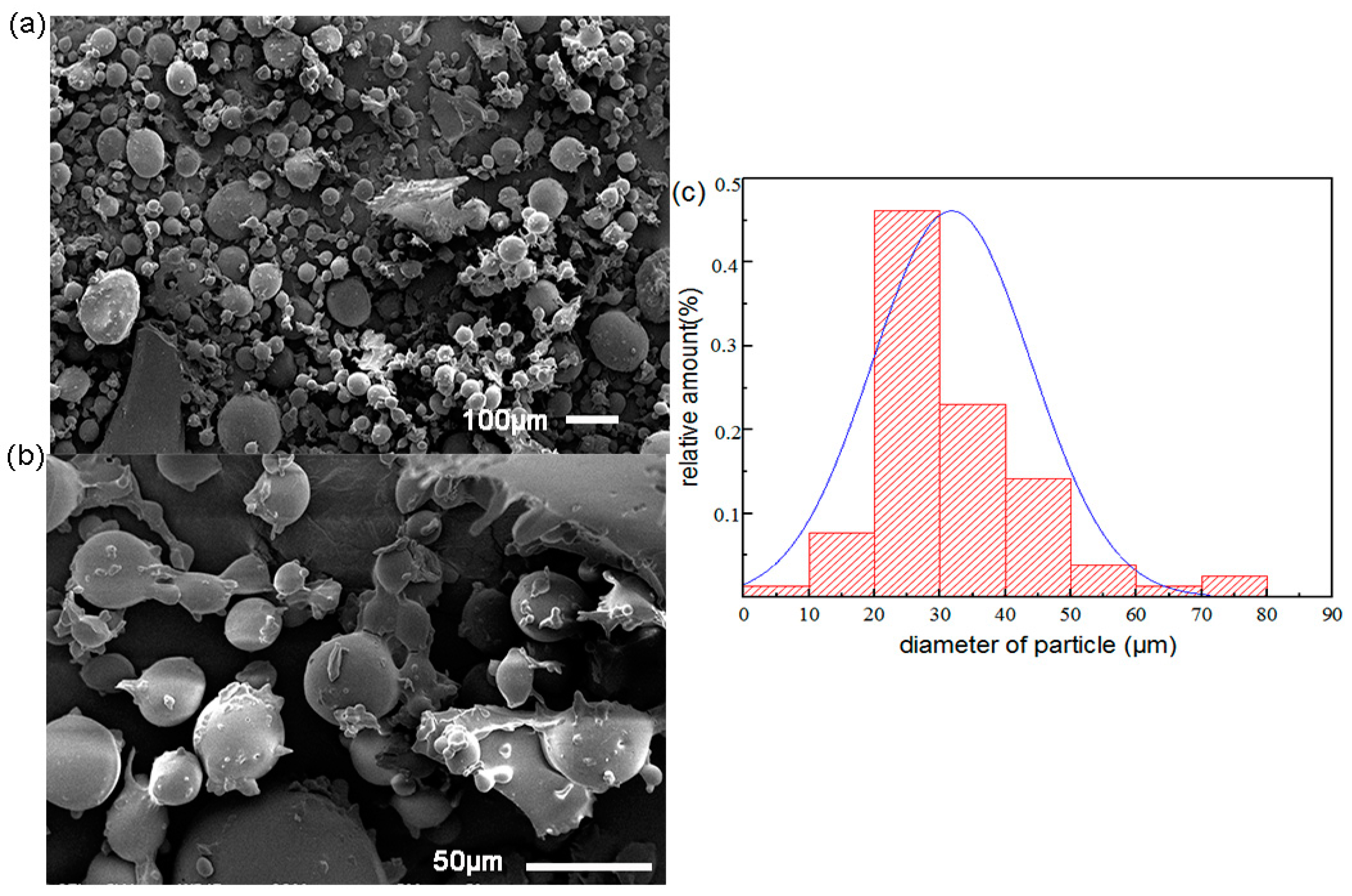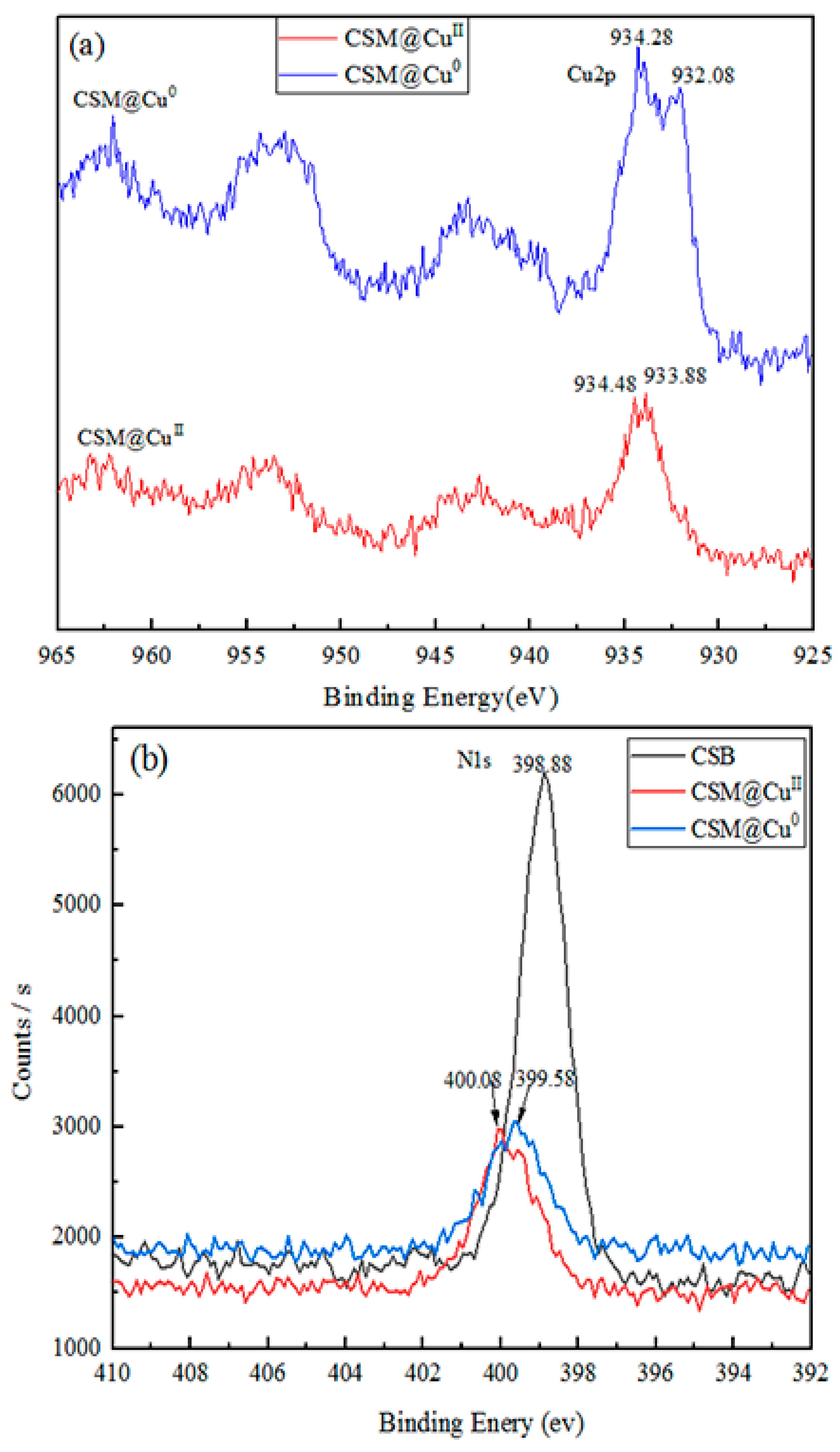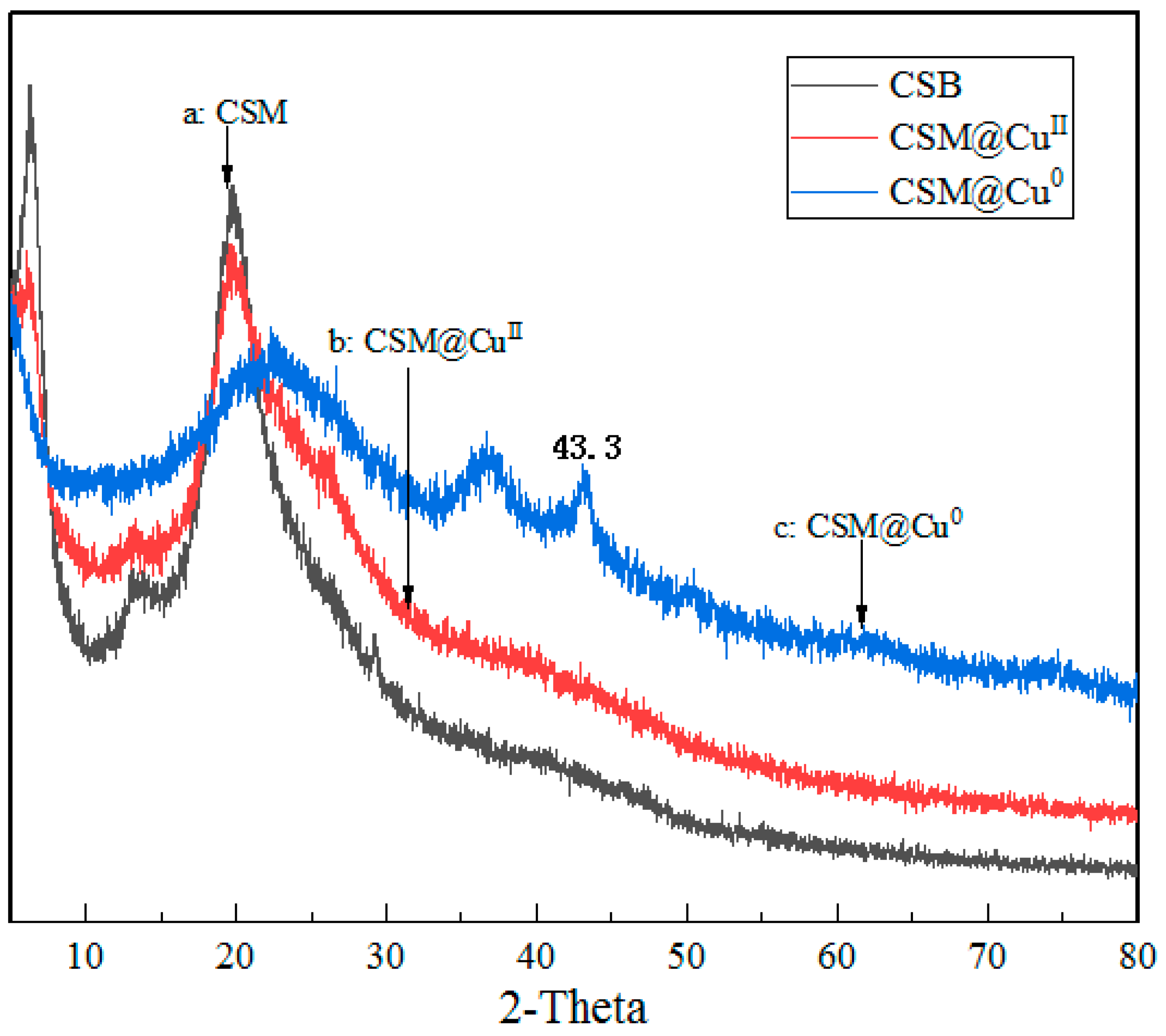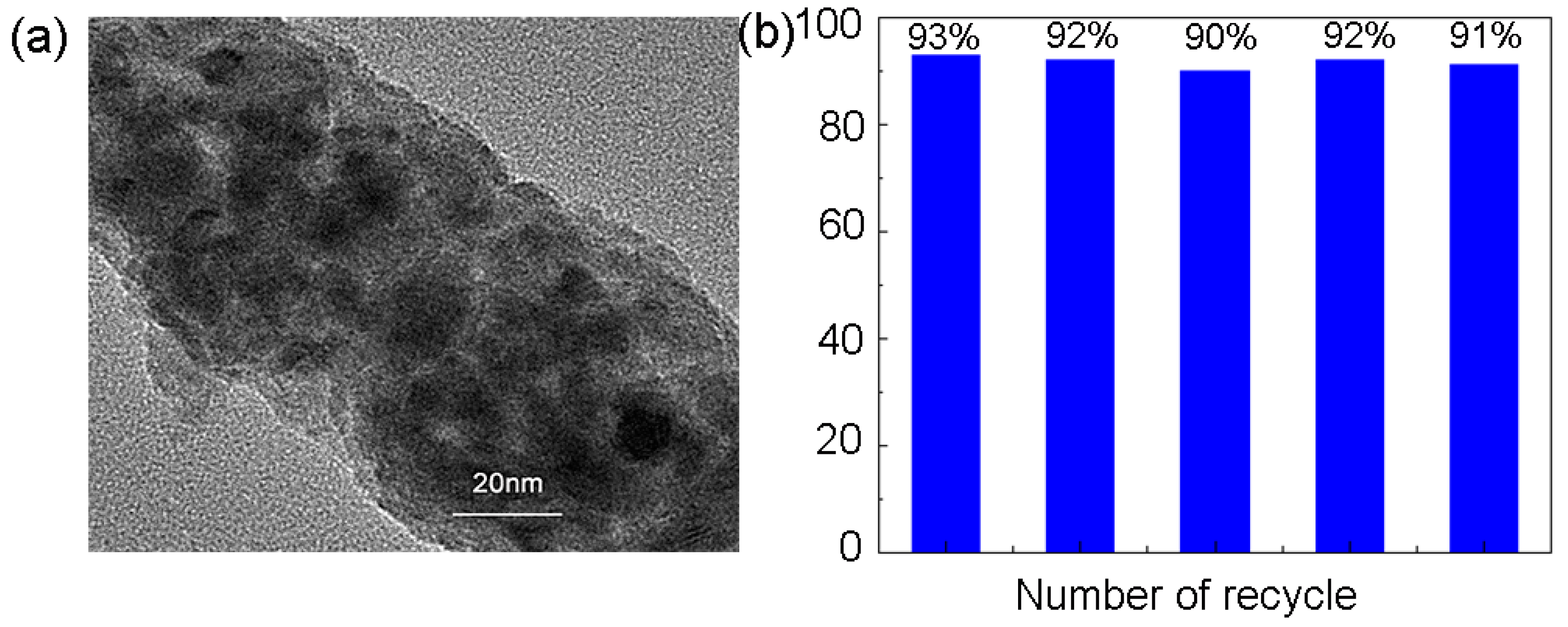Preparation of Modified Chitosan Microsphere-Supported Copper Catalysts for the Borylation of α,β-Unsaturated Compounds
Abstract
:1. Introduction
2. Materials and Methods
2.1. Materials
2.2. Synthesis of Chitosan Microspheres
2.3. Analytical Methods
2.4. Adsorption Kinetics Experiments of Cu II
3. Results and Discussion
3.1. Characterization of the Modified Chitosan Microspheres
3.2. Dynamic Adsorption of the Modified Chitosan Microspheres
3.3. Characterization of Supported Cu0 Catalysts.
3.3.1. Thermo-Gravimetric Analyzes
3.3.2. FTIR Characterization
3.3.3. XPS and XRD Characterization
3.3.4. TEM Characterization
3.4. The Performance of Chitosan Microsphere-Supported Cu Catalyzed in a Boron Addition Reaction.
3.4.1. Procedure of CSM@Cu0 Catalyzed in the Boron Addition Reaction
3.4.2. Optimization of the Reaction Conditions.
3.5. Catalyst Reuse
3.6. Extension to Other Substrates
4. Conclusions
Supplementary Materials
Author Contributions
Funding
Acknowledgments
Conflicts of Interest
References
- Rase, H.F. Handbook of commercial catalysts: Heterogeneous catalysts; CRC press: Boca Raton, FL, USA, 2016. [Google Scholar]
- Shrotri, A.; Kobayashi, H.; Fukuoka, A. Cellulose Depolymerization over Heterogeneous Catalysts. Accounts Chem. Res. 2018, 51, 761–768. [Google Scholar] [CrossRef] [PubMed] [Green Version]
- Younes, I.; Rinaudo, M. Chitin and Chitosan Preparation from Marine Sources. Structure, Properties and Applications. Mar. Drugs 2015, 13, 1133–1174. [Google Scholar] [CrossRef] [PubMed] [Green Version]
- Zou, P.; Yang, X.; Wang, J.; Li, Y.; Yu, H.; Zhang, Y.; Liu, G. Advances in characterisation and biological activities of chitosan and chitosan oligosaccharides. Food Chem. 2016, 190, 1174–1181. [Google Scholar] [CrossRef]
- Hardy, J.J.E.; Hubert, S.; MacQuarrie, D.J.; Wilson, A.J. Chitosan-based heterogeneous catalysts for Suzuki and Heck reactions. Green Chem. 2004, 6, 53. [Google Scholar] [CrossRef]
- Cui, Q.; Zhao, H.; Luo, G.; Xu, J. An Efficient Chitosan/Silica Composite Core–Shell Microspheres-Supported Pd Catalyst for Aryl Iodides Sonogashira Coupling Reactions. Ind. Eng. Chem. Res. 2016, 56, 143–152. [Google Scholar] [CrossRef]
- Baran, T.; Menteş, A.; Arslan, H. Synthesis and characterization of water soluble O-carboxymethyl chitosan Schiff bases and Cu(II) complexes. Int. J. Boil. Macromol. 2015, 72, 94–103. [Google Scholar] [CrossRef] [PubMed]
- Antony, R.; Arun, T.; Manickam, S.T.D. A review on applications of chitosan-based Schiff bases. Int. J. Boil. Macromol. 2019, 129, 615–633. [Google Scholar] [CrossRef] [PubMed]
- Liew, K.H.; Lee, T.K.; Yarmo, M.A.; Loh, K.S.; Peixoto, A.F.; Freire, C.; Yusop, R.M. Ruthenium Supported on Ionically Cross-linked Chitosan-Carrageenan Hybrid MnFe2O4 Catalysts for 4-Nitrophenol Reduction. Catal. 2019, 9, 254. [Google Scholar] [CrossRef]
- Alhokbany, N.; Ahama, T.; Ruksana, M.N.; Naushad, M.; AlShehri, S.M.; Ahamad, T. AgNPs embedded N- doped highly porous carbon derived from chitosan based hydrogel as catalysts for the reduction of 4-nitrophenol. Compos. Part B: Eng. 2019, 173, 106950. [Google Scholar] [CrossRef]
- Lang, X.; He, L. ChemInform Abstract: Green Catalytic Process for Cyclic Carbonate Synthesis from Carbon Dioxide under Mild Conditions. Chemin 2016, 47, 1337–1352. [Google Scholar] [CrossRef]
- Baran, T.; Menteş, A. Highly efficient Suzuki cross-coupling reaction of biomaterial supported catalyst derived from glyoxal and chitosan. J. Organomet. Chem. 2016, 803, 30–38. [Google Scholar]
- Bradshaw, M.; Zou, J.; Byrne, L.; Iyer, K.S.; Stewart, S.G.; Raston, C.L. Pd(ii) conjugated chitosan nanofibre mats for application in Heck cross-coupling reactions. Chem. Commun. 2011, 47, 12292. [Google Scholar]
- Franconetti, A.; DomÃnguez-RodrÃguez, P.; Lara-GarcÃa, D.; Prado-Gotor, R.; Cabrera-Escribano, F. Native and modified chitosan-based hydrogels as green heterogeneous organocatalysts for imine-mediated Knoevenagel condensation. Appl. Catal., A. 2016, 517, 176–186. [Google Scholar] [CrossRef]
- Cui, Y.; Qin, Y.; Zhao, W.; Yang, L.; Zhang, X. Chitosan-Based Heterogeneous Catalysts for Enantioselective Michael Reaction. Chirality 2012, 24, 640–645. [Google Scholar]
- Ghozlan, S.A.; Ahmed, A.G.; Abdelhamid, I.A. Regioorientation in the Addition Reaction of a-Substituted Cinnamonitrile to Enamines Utilizing Chitosan as a Green Catalyst: Unambiguous Structural Characterization Using 2D-HMBC NMR Spectroscopy. J. Heterocycl. Chem. 2016, 53, 817–823. [Google Scholar]
- Souillart, L.; Cramer, N. Catalytic C–C Bond Activations via Oxidative Addition to Transition Metals. Chem. Rev. 2015, 115, 9410–9464. [Google Scholar] [PubMed]
- Reetz, M.T. Directed Evolution of Artificial Metalloenzymes: A Universal Means to Tune the Selectivity of Transition Metal Catalysts? Accounts Chem. Res. 2019, 52, 336–344. [Google Scholar]
- Kloekhorst, A.; Heeres, H.J. Catalytic Hydrotreatment of Alcell Lignin Using Supported Ru, Pd, and Cu Catalysts. ACS Sustain. Chem. Eng. 2015, 3, 1905–1914. [Google Scholar]
- Hronec, M.; Fulajtarová, K.; Vávra, I.; Soták, T.; Dobročka, E.; Mičušík, M. Carbon supported Pd–Cu catalysts for highly selective rearrangement of furfural to cyclopentanone. Appl. Catal. B: Environ. 2016, 181, 210–219. [Google Scholar] [CrossRef]
- Iwasa, N.; Kudo, S.; Takahashi, H.; Masuda, S.; Takezawa, N. Highly selective supported Pd catalysts for steam reforming of methanol. Catal. Lett. 1993, 19, 211–216. [Google Scholar]
- Chen, H.-Y.; Wei, Z.; Kollar, M.; Gao, F.; Wang, Y.; Szanyi, J.; Peden, C.H. A comparative study of N2O formation during the selective catalytic reduction of NOx with NH3 on zeolite supported Cu catalysts. J. Catal. 2015, 329, 490–498. [Google Scholar] [CrossRef] [Green Version]
- Kiriakos, N.; Nikolaos, D.; Dimitrios, G.; Maria, A. Comparative study of Ni, Co, Cu supported on ³-alumina catalysts for hydrogen production via the glycerol steam reforming reaction. Fuel Process. Technol. 2016, 152, 156–175. [Google Scholar]
- Evano, G.; Blanchard, N. Copper-mediated cross-coupling reactions, Wiley Online Library, 2014.
- Thomas, A.M.; Sujatha, A.; Anilkumar, G. Recent advances and perspectives in copper-catalyzed Sonogashira coupling reactions. RSC Adv. 2014, 4, 21688–21698. [Google Scholar]
- Sonawane, R.B.; Rasal, N.K.; Bhange, D.S.; Jagtap, S.V. Copper(II) Catalyzed N-Formylation and N- Acylation of Aromatic, Aliphatic, and Heterocyclic Amines and a Preventive Study in the C-N Cross Coupling of Amines with Aryl Halides. Chem. Cat. Chem. 2018, 10, 3907–3913. [Google Scholar]
- Wei, L.; Yanlan, B. Progress in copper-catalyzed direct arylation of aromatic C-H bonds. Chin. J. Org. Chem. 2012, 32, 1041–1050. [Google Scholar]
- Chen, B.; Hou, X.-L.; Li, Y.-X.; Wu, Y.-D. Mechanistic Understanding of the Unexpected Meta Selectivity in Copper-Catalyzed Anilide C–H Bond Arylation. J. Am. Chem. Soc. 2011, 133, 7668–7671. [Google Scholar] [CrossRef] [PubMed]
- Haizhu, Y.; Shengqin, S.; Chi, Z.; Zhi-Min, D. Recent Progress in Copper Catalyzed CH Functionalizations. Chin. J. Org. Chem. 2013, 33, 1628–1646. [Google Scholar]
- Smoum, R.; Rubinstein, A.; Dembitsky, V.M.; Srebnik, M. Boron Containing Compounds as Protease Inhibitors. Chem. Rev. 2012, 112, 4156–4220. [Google Scholar]
- Molander, G.A.; Ellis, N. Organotrifluoroborates: Protected Boronic Acids That Expand the Versatility of the Suzuki Coupling Reaction. Accounts Chem. Res. 2007, 40, 275–286. [Google Scholar] [CrossRef]
- O’Farrell, A.M.; Van Vliet, A.; Farha, K.A.; Cherrington, J.M.; Campbell, D.A.; Li, X.; Hanway, D.; Li, J.; Guler, H.-P. Pharmacokinetic and Pharmacodynamic Assessments of the Dipeptidyl Peptidase-4 Inhibitor PHX1149: Double-Blind, Placebo-Controlled, Single- and Multiple-Dose Studies in Healthy Subjects. Clin. Ther. 2007, 29, 1692–1705. [Google Scholar]
- Ito, H.; Yamanaka, H.; Tateiwa, J.-i.; Hosomi, A. Boration of an a,b-enone using a diboron promoted by a copper (I)-TMphosphine mixture catalyst. Tetrahedron Letters. 2000, 41, 6821–6825. [Google Scholar]
- Chea, H.; Sim, H.-S.; Yun, J. Ligandless Copper-Catalyzed a-Boration of a,b-Unsaturated Compounds in Aqueous Solution. Bull. Korean Chem. Soc. 2010, 31, 551–552. [Google Scholar] [CrossRef]
- Kitanosono, T.; Kobayashi, S. Asymmetric Boron Conjugate Additions to Enones in Water Catalyzed by Copper(0). Asian, J. Org. Chem. 2013, 2, 961–966. [Google Scholar]
- Xu, P.; Li, B.; Wang, L.; Qin, C.; Zhu, L. A green and recyclable chitosan supported catalyst for the borylation of α, β-unsaturated acceptors in water. Catal. Commun. 2016, 86, 23–26. [Google Scholar]
- Wen, W.; Han, B.; Yan, F.; Ding, L.; Li, B.; Wang, L.; Zhu, L. Borylation of a,b-Unsaturated Acceptors by Chitosan Composite Film Supported Copper Nanoparticles. Nanomaterials. 2018, 8, 326. [Google Scholar]
- Peng, H.; Xiong, H.; Li, J.; Xie, M.; Liu, Y.; Bai, C.; Chen, L. Vanillin cross-linked chitosan microspheres for controlled release of resveratrol. Food Chem. 2010, 121, 23–28. [Google Scholar]
- Teong, L.; Hanafiah, M.A.K.M.; Ngah, W.W. Adsorption of dyes and heavy metal ions by chitosan composites: A review. Carbohydr. Polym. 2011, 83, 1446–1456. [Google Scholar]
- Hong, P.-Z.; Li, S.-D.; Ou, C.-Y.; Li, C.-P.; Yang, L.; Zhang, C.-H. Thermogravimetric analysis of chitosan. J. Appl. Polym. Sci. 2007, 105, 547–551. [Google Scholar]
- Lawrie, G.; Keen, I.; Drew, B.; Chandler-Temple, A.; Rintoul, L.; Fredericks, P.; Grøndahl, L. Interactions between alginate and chitosan biopolymers characterized using FTIR and XPS. Biomacromolecules 2007, 8, 2533–2541. [Google Scholar] [CrossRef]
- Gandhi, M.R.; Kousalya, G.; Meenakshi, S. Removal of copper(II) using chitin/chitosan nano-hydroxyapatite composite. Int. J. Boil. Macromol. 2011, 48, 119–124. [Google Scholar] [CrossRef]
- Pawlak, A.; Mucha, M. Thermogravimetric and FTIR studies of chitosan blends. Thermochim. Acta 2003, 396, 153–166. [Google Scholar] [CrossRef]
- Xu, Y.; Du, Y.; Huang, R.; Gao, L. Preparation and modification of N-(2-hydroxyl) propyl-3-trimethyl ammonium chitosan chloride nanoparticle as a protein carrier. Biomater. 2003, 24, 5015–5022. [Google Scholar]
- Biesinger, M.C.; Lau, L.W.; Gerson, A.R.; Smart, R.S. Resolving surface chemical states in XPS analysis of first row transition metals, oxides and hydroxides: Sc, Ti, V., Cu and Zn. Appl. Surf. Sci. 2010, 257, 887–898. [Google Scholar] [CrossRef]
- Clausen, B.; Steffensen, G.; Fabius, B.; Villadsen, J.; Feidenhans, R.; Topsøe, H. In situ cell for combined XRD and on-line catalysis tests: Studies of Cu-based water gas shift and methanol catalysts. J. Catal. 1991, 132, 524–535. [Google Scholar]










| Entry | Conc. before Adsorption (C0, mg/L) | Adsorption Time (min) | Conc. after Adsorption (Ci, mg/L) | Adsorption conc. (mg/L) | Adsorption (%) | Absorption Capacity (qi, mg/g) |
|---|---|---|---|---|---|---|
| 1 | 18.96 a | 180 | 0.49 | 18.47 | 97.42 | 18.47 |
| 2 | 40.75 a | 180 | 0.93 | 39.82 | 97.72 | 39.82 |
| 3 | 59.95 a | 180 | 2.21 | 57.74 | 96.31 | 57.74 |
| 4 | 81.22 a | 180 | 3.11 | 78.11 | 96.17 | 78.11 |
| 5 | 100.63 a | 180 | 2.62 | 98.01 | 97.40 | 98.01 |
| 6 | 100.63 a | 5 | 45.72 | 54.91 | 54.57 | 54.91 |
| 7 | 100.63 a | 10 | 26.33 | 74.3 | 73.83 | 74.3 |
| 8 | 100.63 a | 20 | 17.25 | 83.38 | 82.86 | 83.38 |
| 9 | 100.63 a | 30 | 4.30 | 96.33 | 95.73 | 96.33 |
| /10 | 100.63 a | 60 | 3.13 | 97.5 | 96.89 | 97.5 |
| 11 | 100.63 a | 90 | 3.09 | 97.54 | 96.93 | 97.54 |
| 12 | 100.63 a | 120 | 2.72 | 97.81 | 97.20 | 97.81 |
| 13 | 100.63 a | 150 | 2.70 | 97.93 | 97.32 | 97.93 |
| 14 | 100.63 a | 240 | 2.67 | 97.96 | 97.35 | 97.96 |
| 15 | 100.63 a | 300 | 2.69 | 97.94 | 97.33 | 97.94 |
| 16 | 100.63 b | 180 | 97.33 | 3 | 2.98 | 3 |
| 17 | 100.63 c | 180 | 64.42 | 36.19 | 35.96 | 36.19 |
| 18 | 100.63 d | 180 | 15.67 | 84.96 | 84.43 | 84.96 |

| Entry. | Catalyst | Solvent (1 mL) | Time (h) | Yield (%) |
|---|---|---|---|---|
| 1 | CSM@ Cu0 | Toluene | 8 | 11 |
| 2 | CSM@ Cu0 | Et2O | 8 | 4 |
| 3 | CSM@ Cu0 | Acetone | 8 | 24 |
| 4 | CSM@ Cu0 | THF | 8 | 35 |
| 5 | CSM@ Cu0 | MeOH | 8 | 83 |
| 6 | CSM@ Cu0 | H2O | 8 | 26 |
| 7 | CSM@ Cu0 | MeOH:H2O (4:1) | 8 | 87 |
| 8 | CSM@ Cu0 | MeOH:H2O (3:1) | 8 | 90 |
| 9 | CSM@ Cu0 | MeOH:H2O (2:1) | 8 | 89 |
| 10 | CSM@ Cu0 | MeOH:H2O (1:1) | 8 | 93 a |
| 11 | CSM@ Cu0 | MeOH:H2O (1:2) | 8 | 85 |
| 12 | CSM@ Cu0 | MeOH:H2O (1:3) | 8 | 84 |
| 13 | CSM@ Cu0 | MeOH:H2O (1:1) | 8 | 85 |
| 14 | CSM@ Cu0 | MeOH:H2O (1:1) | 6 | 73 |
| 15 | CSM@ Cu0 | MeOH:H2O (1:1) | 12 | 92 |
| 16 | CSM@ Cu0 | MeOH:H2O (1:1) | 24 | 93 |
| 17 | CSM | MeOH:H2O (1:1) | 8 | NR |
| 18 | CSM@ CuII | MeOH:H2O (1:1) | 8 | 91 b |
 |
 |
© 2019 by the authors. Licensee MDPI, Basel, Switzerland. This article is an open access article distributed under the terms and conditions of the Creative Commons Attribution (CC BY) license (http://creativecommons.org/licenses/by/4.0/).
Share and Cite
Wang, W.; Xiao, Z.; Huang, C.; Zheng, K.; Luo, Y.; Dong, Y.; Shen, Z.; Li, W.; Qin, C. Preparation of Modified Chitosan Microsphere-Supported Copper Catalysts for the Borylation of α,β-Unsaturated Compounds. Polymers 2019, 11, 1417. https://doi.org/10.3390/polym11091417
Wang W, Xiao Z, Huang C, Zheng K, Luo Y, Dong Y, Shen Z, Li W, Qin C. Preparation of Modified Chitosan Microsphere-Supported Copper Catalysts for the Borylation of α,β-Unsaturated Compounds. Polymers. 2019; 11(9):1417. https://doi.org/10.3390/polym11091417
Chicago/Turabian StyleWang, Wei, Zufeng Xiao, Chaofan Huang, Kewang Zheng, Yin Luo, Yumin Dong, Zitong Shen, Wei Li, and Caiqin Qin. 2019. "Preparation of Modified Chitosan Microsphere-Supported Copper Catalysts for the Borylation of α,β-Unsaturated Compounds" Polymers 11, no. 9: 1417. https://doi.org/10.3390/polym11091417






